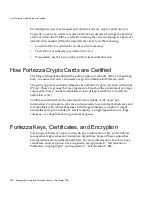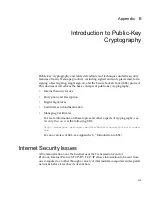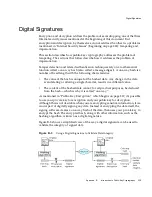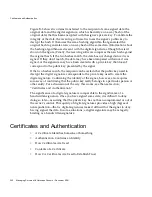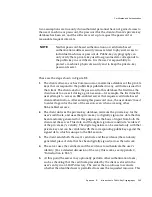
Encryption and Decryption
Appendix
B
Introduction to Public-Key Cryptography
237
Public-Key Encryption
The most commonly used implementations of public-key encryption are based on
algorithms patented by RSA Data Security. Therefore, this section describes the
RSA approach to public-key encryption.
Public-key encryption (also called asymmetric encryption) involves a pair of
keys—a public key and a private key—associated with an entity that needs to
authenticate its identity electronically or to sign or encrypt data. Each public key is
published, and the corresponding private key is kept secret. (For more information
about the way public keys are published, see “Certificates and Authentication,”
which begins on page 240.) Data encrypted with your public key can be decrypted
only with your private key. Figure B-2 shows a simplified view of the way
public-key encryption works.
Figure B-2
Public-Key Encryption
The scheme shown in Figure B-2 lets you freely distribute a public key, and only
you will be able to read data encrypted using this key. In general, to send
encrypted data to someone, you encrypt the data with that person’s public key,
and the person receiving the encrypted data decrypts it with the corresponding
private key.
Compared with symmetric-key encryption, public-key encryption requires more
computation and is therefore not always appropriate for large amounts of data.
However, it’s possible to use public-key encryption to send a symmetric key, which
can then be used to encrypt additional data. This is the approach used by the SSL
protocol.
As it happens, the reverse of the scheme shown in Figure B-2 also works: data
encrypted with your private key can be decrypted only with your public key. This
would not be a desirable way to encrypt sensitive data, however, because it means
that anyone with your public key, which is by definition published, could decrypt
the data. Nevertheless, private-key encryption is useful, because it means you can
use your private key to sign data with your digital signature—an important
requirement for electronic commerce and other commercial applications of
Summary of Contents for NETSCAPE CONSOLE 6.0 - MANAGING SERVERS
Page 1: ...Managing Servers with Netscape Console Netscape Console Version6 0 December 2001 ...
Page 18: ...Getting Additional Help 18 Managing Servers with Netscape Console December 2001 ...
Page 20: ...20 Managing Servers with Netscape Console December 2001 ...
Page 40: ...Uninstallation 40 Managing Servers with Netscape Console December 2001 ...
Page 42: ...42 Managing Servers with Netscape Console December 2001 ...
Page 80: ...Working with Netscape Servers 80 Managing Servers with Netscape Console December 2001 ...
Page 110: ...110 Managing Servers with Netscape Console December 2001 ...
Page 118: ...The Netscape Administration Page 118 Managing Servers with Netscape Console December 2001 ...
Page 166: ...166 Managing Servers with Netscape Console December 2001 ...
Page 208: ...Using Client Authentication 208 Managing Servers with Netscape Console December 2001 ...
Page 226: ...Using the Windows NT SNMP Service 226 Managing Servers with Netscape Console December 2001 ...
Page 228: ...228 Managing Servers with Netscape Console December 2001 ...
Page 264: ...Managing Certificates 264 Managing Servers with Netscape Console December 2001 ...
Page 280: ...The SSL Handshake 280 Managing Servers with Netscape Console December 2001 ...
Page 302: ...302 Managing Servers with Netscape Console December 2001 ...








